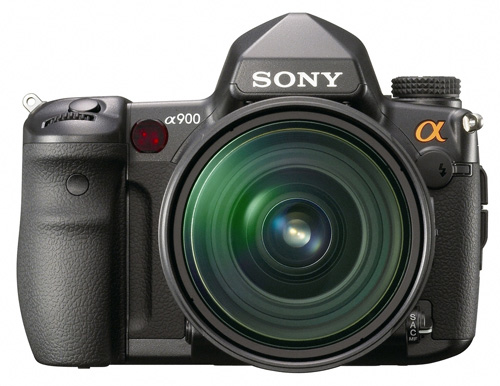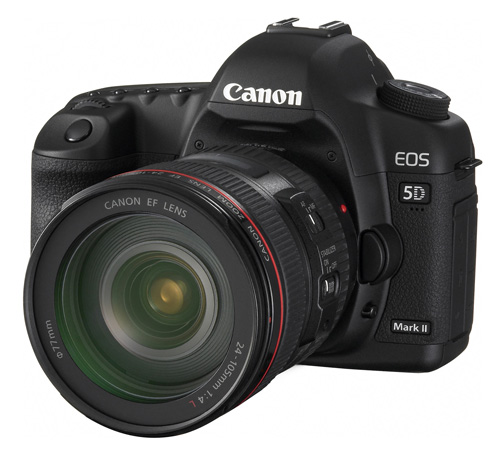Photokina 2008: Full-Frame and Megapixels Rule
by Wesley Fink on September 26, 2008 2:00 AM EST- Posted in
- Digital Camera
Full-Frame Takes Over the High-End
Almost two years ago, in our year-end DSLR Buying Guide, we talked about the likelihood that full-frame would take over the pro and high-end of the DSLR market. Frankly, it has happened even faster that we imagined. If there was any doubt that the full-frame sensor would rule the high-end it has been laid to rest at Photokina 2008.
Sony likes to point out in presentations that they are now the clear number three in the camera market. That certainly has been confirmed recently by Mizuho Securities Equity Research in Tokyo, who found Sony has a 12% share of the DSLR market in the second quarter of 2008. This is more than double the Olympus market share. Sony has made great strides since acquiring Minolta, but it is still a long way to the 40%+ Canon DSLR market share in the same second quarter or the 30% Nikon share reported by Mizuho. Interesting enough, the Sony DSLR market share in some European markets is approaching 25%, or roughly double the US share.
Perhaps most interesting from the Mizuho data is the high cost Sony is paying to earn that market share. In the period from April to June 2008:
| DSLR Operating Profit Margin | ||
| Company | DSLR Shipments | Operating Profit Margin |
| Canon | 1050000 | 23.20% |
| Nikon | 820000 | 19.10% |
| Sony | 330000 | -16.70% |
| Olympus | 150000 | -6.70% |
The report grouped all other cameras in the "Other" category and did not break out data for Pentax for example. Sony has deep pockets, but as a corporation we have to wonder how long Sony will tolerate this "bleeding" in their quest to win DSLR market share. To Sony's credit, they stuck with their plan and forged ahead to offer a "pro-friendly" full-frame Sony DSLR.

The $3000 Sony A900 was launched at Photokina with the clear goal of demonstrating Sony's prowess in the digital sensor market. It is no real secret that Sony produces digital sensors for most other DSLRs in addition to their own brand. The quest to top the resolution chart is closely tied to Sony's desire to drive that point home to the market.
Sony does not appear to have addressed the high ISO sensitivity in the same manner as the most recent Canon and Nikon full-frame cameras, but a full test when the A900 ships will shed more light on this question. For now, the Sony remains the only full-frame DSLR with body-integrated Image Stabilization (IS) that will work with any lens that can mount on the camera.

The Canon 5D is the camera that launched the "semi-pro" full-frame DSLR market, although many will wonder how a camera that originally sold for $3500 targeted "advanced amateurs". However, the 5D is now almost 3 years old. The replacement for the 5D has been "missing in action" for so long that many wondered if Canon had any plans to update a camera that was losing its competitive edge. The answer was cleverly hyped and announced just before the start of Photokina 2008, with the long-expected moniker of Canon 5D Mark II. While industry observers expected an increase in resolution, most did not expect Canon to move all the way to 21.1MP. This is the same resolution as the $8000 Canon 1Ds Mark III, but the 5D sensor is even better. It has ISO options to 25600 - providing both amazing resolution with amazing low-light sensitivity if it performs as promised.
With the big three - Canon, Nikon, and Sony - all now having at least one full-frame model at the top, it should now be clear that the high-end and pro markets have completely shifted to the full-frame sensor with no lens factor for the lenses. As predicted two years ago, the APS-C sensors will now be for entry and midrange cameras in the DSLR market. That, of course, means that all the lens manufacturers will be forced to produce better full-frame lenses with better resolution - or fall by the wayside as full-frame takes the high-end market.
To put in perspective where full-frame can go and what it can do, just look at the charts on page two. The highest resolution full-frame (Sony A900) is still lower pixel density, at 2.9MP per square centimeter, than any current APS-C DSLR. In fact if today'sMP leader in APS-C cameras (Panasonic G1) were to use the same pixel density in a full-frame sensor, that resolution would be 43MP. In more familiar terms, if the resolution of the new Canon 50D were to be carried over to full-frame that sensor would be 38.8MP. The point: full-frame sensors will definitely feature even higher resolutions, with every expectation of good high-ISO performance.










16 Comments
View All Comments
haplo602 - Friday, September 26, 2008 - link
sorry guys but WTF are you talking about? how is the AF type relevant to lens motor operation ?I mean the adapter should be translating the signals to the lens properly (unless 4/3 lenses are screw blade driven).
also you could then not AF in LiveView on regular 4/3 systems as they use contrast detect as one of the AF modes ...
please explain ... I am a bit puzzled here ...
Wesley Fink - Friday, September 26, 2008 - link
Obviously it should be 4/3 and not 4/5 in my reply. We DO need an EDIT function.Wesley Fink - Friday, September 26, 2008 - link
Olympus made it clear in specifications (and our testing of the E-520 and Panasonic Lumix L10) that only these four lenses are compatible with contrast detect. You can easily check the E-520 focusing specifications for yourself at http://www.olympusamerica.com/cpg_section/product....">http://www.olympusamerica.com/cpg_section/product.....Since the contrast-detect AF compatibility on these lenses just required a firmware update perhaps more 4/5 lenses will be contrast AF compatible in the future. That is unknown right now.
haplo602 - Friday, September 26, 2008 - link
ah thanks for the link.It seems a bit stupid however :) I mean what does the lens do while focusing ? It just receives signals from the camera which way to move the lens groups. It does nothing in the focus evaluation.
haplo602 - Friday, September 26, 2008 - link
there should be an EDIT function ...EDIT of the above post: Please make a section specific to G1, it is NOT an APS-C DSLR :-)
Wesley Fink - Friday, September 26, 2008 - link
It is not a DSLR but it does use a sensor that fits the broad APS-C category, where 4/3 cameras currently compete. We were very clear to call it an interchangeable lens camera without a mirror box.We have changed the description to APS-C cameras for a more precise description.